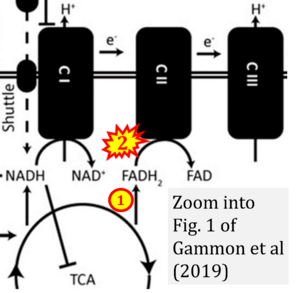Gammon 2019 Cells
| Gammon ST, Pisaneschi F, Bandi ML, Smith MG, Sun Y, Rao Y, Muller F, Wong F, De Groot J, Ackroyd J, Mawlawi O, Davies MA, Gopal YNV, Di Francesco ME, Marszalek JR, Dewhirst M, Piwnica-Worms D (2019) Mechanism-specific pharmacodynamics of a novel Complex-I inhibitor quantified by imaging reversal of consumptive hypoxia with [18F]FAZA PET in vivo. Cells 8:1487. https://doi.org/10.3390/cells8121487 |
Gammon ST, Pisaneschi F, Bandi ML, Smith MG, Sun Y, Rao Y, Muller F, Wong F, De Groot J, Ackroyd J, Mawlawi O, Davies MA, Gopal YNV, Di Francesco ME, Marszalek JR, Dewhirst M, Piwnica-Worms D (2019) Cells
Abstract: Tumors lack a well-regulated vascular supply of O2 and often fail to balance O2 supply and demand. Net O2 tension within many tumors may not only depend on O2 delivery but also depend strongly on O2 demand. Thus, tumor O2 consumption rates may influence tumor hypoxia up to true anoxia. Recent reports have shown that many human tumors in vivo depend primarily on oxidative phosphorylation (OxPhos), not glycolysis, for energy generation, providing a driver for consumptive hypoxia and an exploitable vulnerability. In this regard, IACS-010759 is a novel high affinity inhibitor of OxPhos targeting mitochondrial complex-I that has recently completed a Phase-I clinical trial in leukemia. However, in solid tumors, the effective translation of OxPhos inhibitors requires methods to monitor pharmacodynamics in vivo. Herein, 18F-fluoroazomycin arabinoside ([18F]FAZA), a 2-nitroimidazole-based hypoxia PET imaging agent, was combined with a rigorous test-retest imaging method for non-invasive quantification of the reversal of consumptive hypoxia in vivo as a mechanism-specific pharmacodynamic (PD) biomarker of target engagement for IACS-010759. Neither cell death nor loss of perfusion could account for the IACS-010759-induced decrease in [18F]FAZA retention. Notably, in an OxPhos-reliant melanoma tumor, a titration curve using [18F]FAZA PET retention in vivo yielded an IC50 for IACS-010759 (1.4 mg/kg) equivalent to analysis ex vivo. Pilot [18F]FAZA PET scans of a patient with grade IV glioblastoma yielded highly reproducible, high-contrast images of hypoxia in vivo as validated by CA-IX and GLUT-1 IHC ex vivo. Thus, [18F]FAZA PET imaging provided direct evidence for the presence of consumptive hypoxia in vivo, the capacity for targeted reversal of consumptive hypoxia through the inhibition of OxPhos, and a highly-coupled mechanism-specific PD biomarker ready for translation.
• Bioblast editor: Gnaiger E
Correction: FADH2 and Complex II
- FADH2 is shown as the substrate feeding electrons into Complex II (CII). This is wrong and requires correction - for details see Gnaiger (2024).
- Gnaiger E (2024) Complex II ambiguities ― FADH2 in the electron transfer system. J Biol Chem 300:105470. https://doi.org/10.1016/j.jbc.2023.105470 - »Bioblast link«
Labels: MiParea: Pharmacology;toxicology Pathology: Cancer Stress:Hypoxia
Enzyme: Complex I Regulation: Inhibitor


